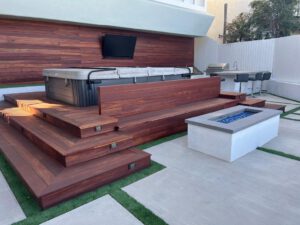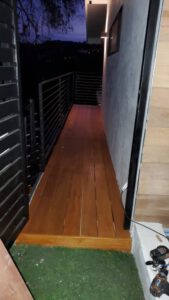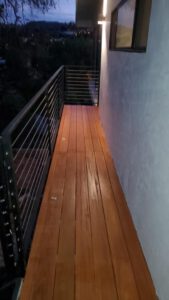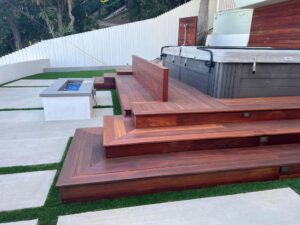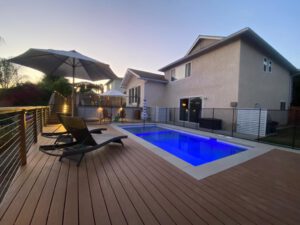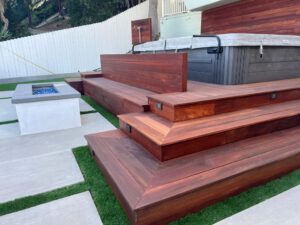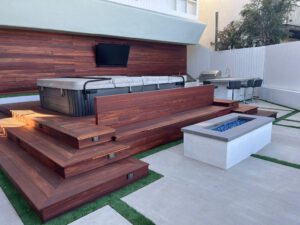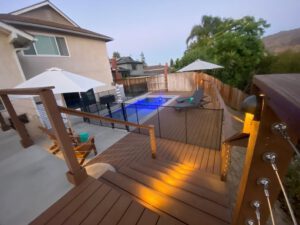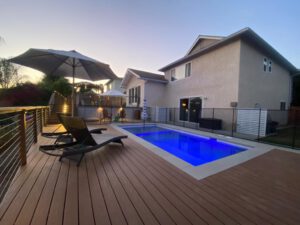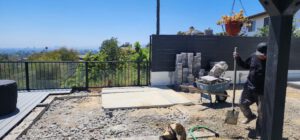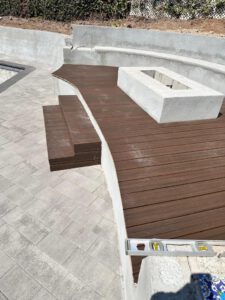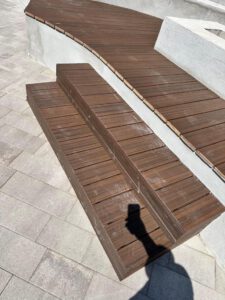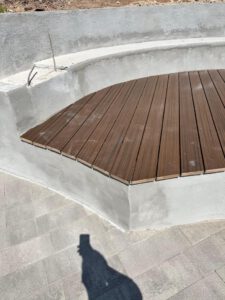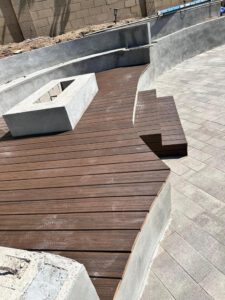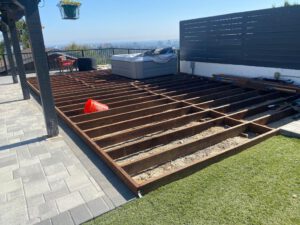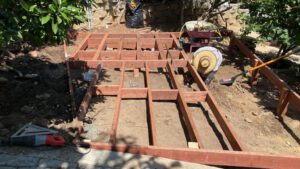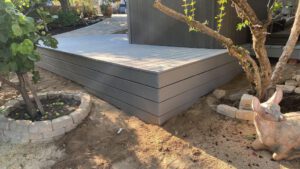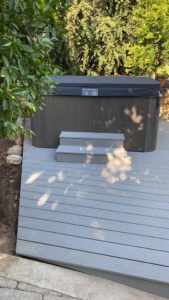Your Dream Deck, Our Expertise
We offer a wide range of decks’ styles, from simple to complete installations and replacements
Request a FREE ESTIMATE
We Will Contact You
Enter your information

5/5
Read BBB Reviews

5/5
Read Nextdoor Reviews

5/5
Read Yelp Reviews
Flooring services at West Hills
West Hills Decking Solutions by ACD Builders
Given West Hills’ unique climate, with its short, arid summers and long, chilly winters, you need a deck that offers both comfort and durability. ACD Builders is here to meet that need by providing the top deck installation and replacement services in West Hills.
Why Choose ACD Builders for Your Decking Needs?
We pride ourselves on delivering premium services at competitive prices. In West Hills, few decking companies can cater to the region’s unique requirements as we do. With us, you can expect unmatched quality and dedication.
Decking Options Tailored for West Hills
Wooden Decks:
- Known for its traditional and timeless appeal.
- Our team excels in hardwood deck installation.
- Offers insulation, making it perfect for West Hills’ climate.
Composite Decks:
- Durable and available in various designs.
- Known for its longevity and eco-friendliness.
- Maintains a comfortable temperature throughout the year.
Vinyl Decks:
- Mimics the look of wood without the high cost.
- Popular for its durability and easy maintenance.
- Installed with precision for lasting results.
Deck Maintenance Services
- Cleaning: Regular cleaning to remove potential stains and debris.
- Inspection: Regular checks for signs of wear or damage.
- Repairing: Prompt repairs or replacements with client approval.
- Expert Advice: Guidance on best practices and solutions for any decking issues.
What Sets ACD Builders Apart?
Our commitment to building trust with our clients is evident in our meticulous planning and consistent high-quality work. With a dedicated team, competitive pricing, and the drive to be West Hills’ top decking service provider, our values of sincerity, honesty, and trust make us stand out.
Why Choose ACD Builders?
Our unwavering integrity, dedication, and passion for customer satisfaction set us apart. Every project is a chance to forge lasting relationships with our clients. We remain available for any queries or concerns, even post-project. Your satisfaction is our primary goal, and we always strive to exceed expectations.
Typical Decking Project Scope
- Project Overview: Installation or replacement of decks for specific areas.
- Site Preparation: Removal of old decks, site cleaning, and leveling.
- Material Selection: Type of decking material, brand, color, style, and additional requirements.
- Installation: Laying out the deck, fitting, and securing.
- Finishing: Sealing and polishing as required.
- Inspection and Quality Control: Ensuring the deck is level and defect-free.
- Cleanup: Debris removal and cleaning.
- Warranty and Maintenance: Providing warranty details and maintenance guidelines.
- Project Timeline: Start to finish dates, milestones, and checkpoints.
- Payment Terms: Total cost, payment schedule, and terms.
This scope is tailored for deck installation and replacement. Specific details may vary based on the project’s unique requirements and the type of decking material chosen. Both the client and the contractor should review and agree upon the scope before work commences.
FAQs
The durability of deck materials can vary based on factors like climate, maintenance, and installation quality. However, when it comes to sheer durability, the following deck materials are often considered the most durable:
Composite Decking:
- Made from a blend of wood fibers and plastic, composite decking is designed to mimic the look of natural wood without the maintenance.
- It’s resistant to rot, insects, and UV rays.
- Brands like Trex, TimberTech, and Fiberon offer high-quality composite decking products that can last for decades with minimal maintenance.
PVC (Polyvinyl Chloride) Decking:
- Entirely made of plastic, making it highly resistant to elements that can damage wood decks such as moisture, insects, and UV rays.
- It doesn’t warp, rot, or split and is also resistant to stains and scratches.
- Brands like AZEK are known for their durable PVC decking products.
Tropical Hardwoods (e.g., Ipe, Cumaru, Tigerwood):
- These woods are incredibly dense and resistant to rot, decay, and insect infestation.
- Ipe, for instance, is often cited as one of the most durable decking materials available and can last over 40 years with proper maintenance.
- However, they can be more challenging to work with due to their density and can be more expensive than other decking options.
Aluminum Decking:
- It’s naturally resistant to rust, decay, and insects.
- Aluminum decks are also fireproof and can be cooler underfoot than many other materials in hot climates.
- They are also slip-resistant and can last for decades without significant wear.
Pressure-Treated Wood:
- While not as durable as the materials listed above, pressure-treated wood is still a popular choice due to its affordability.
- The wood is treated with chemicals to resist rot, decay, and termites.
- With proper maintenance, a pressure-treated deck can last 20-25 years.
When choosing a decking material, it’s essential to consider not just durability but also maintenance requirements, aesthetics, cost, and environmental impact. For instance, while tropical hardwoods are incredibly durable, they can be more expensive and may have environmental concerns if not sourced sustainably. On the other hand, while composite and PVC decking might have higher upfront costs than pressure-treated wood, they often have lower long-term maintenance costs and can offer a longer lifespan.
Installing a new deck offers several advantages, both functional and aesthetic. Here are some of the primary benefits:
Increased Home Value:
- A well-designed and maintained deck can significantly increase the resale value of a home. It’s often considered a good return on investment.
Additional Living Space:
- A deck provides additional space for relaxation, dining, and entertaining. It effectively extends the living area of your home to the outdoors.
Aesthetic Appeal:
- A deck can enhance the visual appeal of a home, offering a space that can be decorated with plants, furniture, and lighting.
Versatility:
- Decks can be customized to serve various purposes, from a quiet reading nook to an outdoor kitchen or a space for large gatherings.
Improved Accessibility:
- A deck can provide a seamless transition from indoors to outdoors, making it easier to access your yard or garden.
Increased Enjoyment of Outdoor Space:
- With a deck, homeowners can make the most of their outdoor space, enjoying the fresh air, sunshine, and natural surroundings in comfort.
Cost-Effective:
- Compared to other home additions or renovations, a deck can be a cost-effective way to add usable space to a home.
Variety of Materials:
- There’s a wide range of decking materials available, from natural woods to composites, allowing homeowners to choose a material that fits their aesthetic preferences, maintenance tolerance, and budget.
Quick Construction:
- Depending on the design and size, decks can often be built relatively quickly compared to other home improvement projects.
Enhanced Landscape:
- A deck can be integrated into the landscape design, complementing features like gardens, trees, or pools.
- Functional for Special Events:
- Decks provide an excellent space for hosting events like barbecues, birthday parties, or family gatherings.
- Potential for Enclosure:
- If needed, decks can later be enclosed to create sunrooms, screened porches, or other protected outdoor spaces.
- Sustainability:
- Many decking materials, especially composites, are made from recycled materials, making them a more environmentally friendly option.
- Safety:
- Raised decks can provide a vantage point to monitor activities in the backyard, such as children playing or pets roaming.
When considering a new deck, it’s essential to plan carefully, taking into account the home’s architecture, the landscape, the intended use of the deck, and the budget. Proper planning ensures that the deck serves its intended purpose and provides lasting value to the homeowner.
Planning a budget for a new deck involves several steps to ensure you account for all potential costs and stay within your financial limits. Here’s a step-by-step guide to help you plan your budget:
Determine the Purpose and Size:
- Understand the primary purpose of your deck. Do you want it for entertaining, relaxing, or as an extension of your living space?
- The size and complexity of your deck will significantly influence the cost. Measure or estimate the square footage you desire.
Research Material Costs:
- Different decking materials come with varying costs. Common materials include pressure-treated wood, cedar, redwood, composite, PVC, and tropical hardwoods.
- Consider not only the initial cost but also the long-term maintenance costs associated with each material.
Factor in Labor Costs:
- If you’re hiring a contractor, get multiple quotes to understand the average labor cost in your area.
- If you’re considering a DIY approach, factor in tool rentals or purchases and additional help if needed.
Design and Features:
- Custom designs, built-in seating, railings, multi-levels, and other features can add to the cost.
- Features like pergolas, privacy screens, or built-in lighting will also impact the budget.
Permit and Inspection Fees:
- Check with your local municipality about necessary permits for deck construction. There might be fees associated with obtaining these permits.
- Some localities may also require an inspection, which could have associated costs.
Safety Features:
- Depending on the height and location of your deck, you might need railings, balusters, or other safety features, which can add to the cost.
Landscaping and Site Preparation:
- Preparing the site might involve clearing vegetation, leveling, or even foundation work. These tasks can add to the overall cost.
- Post-construction landscaping or restoring any disrupted areas can also impact the budget.
Contingency Fund:
- It’s wise to set aside an additional 10-20% of your total budget for unexpected costs. This can cover unforeseen challenges, material price fluctuations, or changes you decide to make during construction.
Maintenance and Upkeep:
- While not an immediate cost, consider the long-term maintenance costs of your chosen materials. For instance, wood decks might require regular sealing or staining, while composite decks might have lower maintenance costs over time.
Financing Options:
- If you’re considering financing the deck construction, research available loan options, interest rates, and terms. Ensure the monthly payments fit comfortably within your budget.
- Review and Adjust:
- Once you’ve listed all potential costs, review your budget. If it exceeds your limit, consider adjusting the size, design, or materials to fit within your financial constraints.
- Stay Updated:
- As you proceed with the project, regularly check your expenditures against your budget. This will help you stay on track and make necessary adjustments if costs start to exceed your initial estimates.
By thoroughly researching, planning, and monitoring your budget, you can ensure that your deck project is financially manageable and results in a beautiful addition to your home.
Replacing a deck involves a systematic process to ensure safety, compliance with local building codes, and a successful outcome. Here are the general steps involved in replacing a deck:
Assessment and Planning:
- Inspect the current deck to determine the extent of damage or wear.
- Decide whether a full replacement is necessary or if some components (like the foundation) can be reused.
- Sketch a design for the new deck or consult with a designer or architect.
Obtain Necessary Permits:
- Check with your local municipality or building department to determine the required permits for deck replacement.
- Some localities may require detailed plans, especially for larger or multi-level decks.
Demolition:
- Remove any furniture or accessories from the deck.
- Safely dismantle the old deck, starting with railings, then deck boards, and finally the underlying structure.
- Rent a dumpster or arrange for debris removal.
Inspect and Prepare the Foundation:
- Once the old deck is removed, inspect the foundation or footings. If they’re in good condition, you might be able to reuse them.
- If not, you’ll need to dig new footings. The depth and size will depend on your local building codes and the size of the deck.
Install Posts and Ledger Board:
- Secure a ledger board to the house using lag bolts. This will support one side of the deck.
- Install posts for the outer frame into the footings.
Build the Frame:
- Using pressure-treated lumber, construct the outer frame (rim joists) and attach it to the ledger board and posts.
- Install the inner joists, ensuring they are evenly spaced and securely fastened.
Lay the Decking:
- Starting from the house, lay the deck boards perpendicular to the joists.
- Secure each board with screws or hidden fasteners, ensuring even spacing between boards for drainage.
Install Railings and Stairs (if applicable):
- If your deck is elevated, you’ll need railings for safety. Install posts, top and bottom rails, and balusters.
- Build and attach stairs, ensuring they are sturdy and meet local building codes.
Add Features and Accessories:
- Consider adding built-in benches, planters, or a pergola.
- Install lighting, post caps, or other decorative features.
Seal or Stain the Deck:
- If you’ve used natural wood, you’ll need to seal or stain the deck to protect it from the elements.
- Even if you’ve used pressure-treated wood or hardwood, a sealant can provide added protection.
- Final Inspection:
- Ensure all fasteners are secure, and there are no protruding nails or screws.
- Check the stability of railings and stairs.
- If required by your locality, have a final inspection done by a building inspector.
- Maintenance:
- Regularly inspect your deck for signs of wear or damage.
- Clean it periodically and reseal or restain as needed to prolong its lifespan.
Remember, safety is paramount when replacing a deck. If you’re unsure about any step or don’t have the necessary tools or expertise, consider hiring a professional contractor. They can ensure the job is done correctly, safely, and in compliance with local building codes.
Why Us
1. Unmatched Expertise
Craftsmanship and innovation stand as the pillars of our approach, backed by industry knowledge that ensures your dreams are realized brick by brick in West Hills, California.
2. Timely Deliveries
Every project, big or small, is delivered on schedule, meeting the highest standards of quality, thanks to our dedicated team of specialists.
3. Beyond Brick and Mortar
We believe in building lasting relationships grounded in honesty and trust, going beyond just constructing physical structures.
4. Continuous Support
Our commitment to you extends beyond project completion, offering steadfast support for any future needs.
5. Affordable Excellence
Experience premium construction solutions that are budget-friendly, without compromising on quality and craftsmanship.
Discover the ACD Builders Difference
Join hands with a team where your vision takes center stage, shaping a future in West Hills that is crafted to perfection.

100% Client Satisfaction

Professional Work and Team




